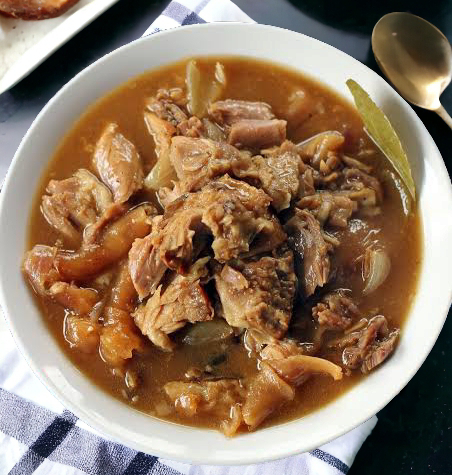Lechon Paksiw stands as a culinary testament to the innovative spirit found within Filipino kitchens. Merely whisper its name and you can nearly hear the crackling of the lechon's skin and the simmering of its succulent remnants transforming into a dish with a uniquely piquant depth. In this guide, we honor tradition and elevate your culinary skills, guiding you through the alchemy of making the quintessential Lechon Paksiw at home.
Setting the Stage with Ingredients and Tools
Before embarking on this gastronomic journey, it is crucial to gather your arsenal. Precision demands quality ingredients and the right equipment. You will need 2 tbsp of vegetable oil to lay the foundation of flavor, while 6 cloves of garlic and 1 pc of onion serve as the aromatic backbone. The hero, 0.75 kg of leftover lechon, awaits its transformation. Seasoning agents like 1 pc bay leaf, 0.25 cup of white vinegar, and 0.25 tsp of ground pepper infuse character into the dish. The contradictions of sweetness and tang will be mediated by 0.25 cup of brown sugar. With 2 cups of water as our solvent, we are ready to begin.
The Aromatic Prelude: Sautéing Basics
Firstly, heat the 2 tbsp of vegetable oil in a deep pan over medium heat, initiating a dance of heat and flavor. Crush the 6 cloves of garlic to unleash their pungent potential, and chop the onion, fortifying the oil with their essence until they achieve a golden transcendence. This sauté ritual lay down the flavorful foundation for our dish.
The Main Attraction: Integrating the Lechon
Introduce the 0.75 kg of lechon into the pan. Allow the pieces to bask in the aromatic oil, onions, and garlic, turning them occasionally to ensure an even embrace of flavors. The lechon should sizzle as it meets its savory companions, entering into a union that sets the stage for a truly indulgent experience.
An Infusion of Acidity and Spice: The Vinegar's Role
After the lechon has browned, pour in 0.25 cup of white vinegar. Do not stir just yet, as the vinegar needs to simmer and work its sharp magic, tenderizing the meat and incorporating its decisive tang. Add 1 bay leaf and 0.25 tsp of ground pepper, infusing the dish with their fragrance.
The Simmering Crescendo: Liquids and Seasonings Merge
Carefully add the 2 cups of water, watching it steam and bubble as it mingles with the vinegar. Now, bring the mixture to a gentle boil. It's time for the flavors to truly marry. At this point, the 0.25 cup of brown sugar enters the scene, dissolving into the burgeoning sauce and cutting through the acidity with its molasses sweetness.
Patience Brews Flavor: The Art of Simmering
It's the slow simmer that coaxes the depth of flavors out of each component. Reduce the heat and allow the concoction to bubble away, the lechon absorbing the melding flavors, becoming tender and even more flavorful.
Serving with Style: The Final Flourish
After a slowly relished simmer, check that the meat is tender to satisfaction – this is your cue to prepare to serve. The sauce should be a thick, sweet, and tangy glaze that generously coats the pork.
Accompaniments: Completing the Feast
Lechon Paksiw is a centerpiece. Complement it with a plate of steaming jasmine rice, or if you're embracing tradition fully, something heartier, like Filipino-style garlic fried rice to absorb the rich sauce.
Leftovers: A Gift That Keeps on Giving
As any lechon paksiw connoisseur knows, much like fine wine, the dish deepens in complexity when given time. Do not fear leftovers, for they promise an even richer experience on day two.
Reflections From the Kitchen: A Culinary Sign-off
Cooking Lechon Paksiw is more than following a recipe; it's about embracing a culture, engaging with history, and participating in a ritual that goes back generations. This dish stands as a celebration of flavor, a testament to the power of renewal and the joy of creativity in the kitchen.






No comments:
Post a Comment